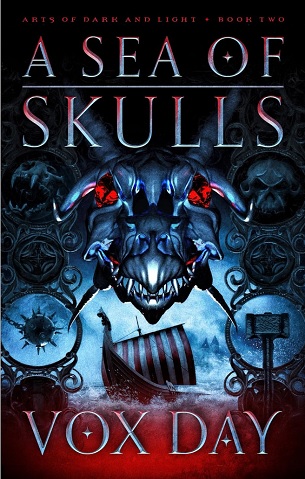 A Sea of Skulls by Vox Day, Castalia House, February 9th, 2024
A Sea of Skulls by Vox Day, Castalia House, February 9th, 2024
While I now regret the gastronomic metaphor I originally used in the title for my review of Summa Elvetica and continued in my review of A Throne of Bones, I am afraid I shall now have to continue this until the series is finished. I do have to apologise to anyone who finds these titles irritating but I value consistency over popularity.
I began re-reading these two books in anticipation of the long-awaited sequel A Sea of Skulls which was finally and fully released in February of last year and is now available on the Arkhaven Store, Amazon and elsewhere. I say “fully” because a shorter version of this was released digitally in late 2016 but I, like many, waited longer for the final edition. I waited further still for the physical release and finally read it over the Christmas holidays late last year.
The short version of this review is that I really enjoyed it and am looking forward to A Grave of Gods which will presumably be the final book in the series. In what follows, I am going to be deliberately vague about plot points as I was in the previous two reviews. Once the series is complete, I may write a more extended post that gives a more thorough analysis but that will be much further into the future.
A Sea of Skulls picks up immediately after the end of A Throne of Bones and while there are many returning characters, there are also new ones introduced. The focus also shifts away from the civil unrest in Amorr and focuses more on other regions and races of Selenoth. This is so much so that Marcus, the main character of the series (at least by prominence across all three books), has a somewhat reduced role to play here. It is still modelled after the structure of G.R.R. Martin’s unfinished A Song of Ice and Fire series with each chapter being named after the character it focuses on. Day has thankfully not gone overboard with new characters introduced the way Martin did and has clearly been careful not to allow the already massive narrative scope become bloated beyond control and indeed — even draws some narrative threads from A Throne of Bones to a close.
The two major characters introduced in A Sea of Skulls are the orc Lugbol and a female elf named Bereth. Both of these characters give a different perspective of the world of Selenoth and it is certainly Lugbol who is the most interesting addition. As the rather shocking Prologue shows, the orcs are an extremely brutal and merciless race. They are not however, entirely without sense or reason and Lugbol’s perspective does a great job of bringing out how the orcs think and feel. He is one of the smaller orcs but his bravery coupled with a better sense of self-preservation and a higher than average intelligence, sees him promoted within the ranks. Although definitely on the wrong side, I imagine many readers will grow to respect and even like Lugbol for what he is though still wanting to see the brutal military machine he is a cog in ultimately destroyed. I assume this was Vox’s intention with the character and if he did intend readers to feel this way then he did a commendable job in achieving it.
The elves played a smaller part in A Throne of Bones but are much more prominent in A Sea of Skulls largely through the eyes of Bereth, one of the elven skyriders who mount their giant hawks. Caitlys who was introduced in Summa Elvetica is also a skyrider and has a smaller though important role in A Sea of Skulls as well. Bereth is witness to an orc invasion advancing slowly but largely unhindered towards the elvish capital Elebrion. Lugbol, it should be added, is part of a separate force invading Savondir to the north-west. The skyriders are successful in hampering the army a number of times through Bereth’s own bravery and ingenuity but not enough to ever halt or turn it back. One of the main themes explored through the elves is how their dwindling population has fatally weakened their race more than the invading enemy ever could have and the orcs are simply taking advantage of their weakness. Superior weaponry and defences are worthless when there aren’t enough elves to wield these weapons or even man the great walls of their northern fortress. The orcs in contrast, overcome their disadvantage in technology with sheer numbers; a tactic that doesn’t require any sophistication.
Although not the focus, Day still includes a few chapters in the lengthy narrative that keep the conflict that exploded particularly in the last third of the original in the back of the reader’s mind. Marcus is caught up in the events happening in Savondir and Fjotra and the fall of her island nation is also continued. There were a few surprises throughout including one minor narrative thread I assumed Vox had abandoned brought to some significance here.
I found myself wondering towards the end how Day is going to bring it all together in the end. I have a number of possible ideas in my head but I will leave them out here as they will give away significant events in A Sea of Skulls. I continue to be impressed by the series and though I expect another long wait, I am confident that Vox Day will deliver with A Grave of Gods. I will likely take one more trip through A Sea of Skulls before it is released.
